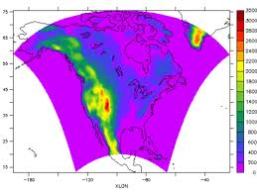source of image from the NARCCAP website
Last week I posted twice on the BAMS article
Linda O. Mearns, Ray Arritt, Sébastien Biner, Melissa S. Bukovsky, Seth McGinnis, Stephan Sain, Daniel Caya, James Correia, Jr., Dave Flory, William Gutowski, Eugene S. Takle, Richard Jones, Ruby Leung, Wilfran Moufouma-Okia, Larry McDaniel, Ana M. B. Nunes, Yun Qian, John Roads, Lisa Sloan, Mark Snyder, 2012: The North American Regional Climate Change Assessment Program: Overview of Phase I Results. Bull. Amer.Met Soc. September issue. pp 1337-1362.
in
E-Mail To Linda Mearns On The 2012 BAMS Article On Dynamic Downscaling
I have had an e-mail response from Linda Mearns and she informed me that she is too busy to respond at this time. I have requested her permission to post her e-mails rejecting my request and will present if she gives me permission.
Quite frankly, I am disappointed as ignoring the issues that I summarized in my two posts is not the proper approach to advancing climate science.
I have succinctly summarized below what are the fundamental flaws in the use of regional downscaling with respect to multi-decadal climate predictions:
My Conclusions:
- The Mearns et al 2012 BAMS paper with respect to type 2 downscaling it is an important new contribution.
- However, it’s application to climate change runs (type 4 downscaling) is inappropriate and misleading to the impacts and policy communities.
In order to refute the second conclusion, these following two questions must be answered in the affirmative:
1. Can a type 4 downscaling can be more accurate than a type 2 downscaling? Otherwise why not just start from regional reanalyses and assess what changes would have to occur in order to cause a negative impact to key resources, as we recommed in Pielke et al 2012. Only then assess what is plausibly possible and how to mitigate/adapt to prevent a negative effect from occuring.
2. Have the regional climate models shown skill in predicting changes over time in regional multi-decadal regional climate statistics?
My answer to both #1 and #2 are NO.
The Mearns et al 2012 BAMS paper uses observed data, as processed through reanalyses, as lateral boundary conditions, and interior nudging when used. This provides a real world constraint on how much the regional model can diverge from reality. This is why we label it as type 2 downscaling.
The results of the Mearns et al 2012 BAMS paper cannot be used to justify providing changes in climate statistics to the impacts communities (i.e. through type 4 downscaling).
The actual ability of climate models to predict (in hindcast) EVEN the current climate is very limited. I documented this with a number of peer-reviewed papers in my posts
More CMIP5 Regional Model Shortcomings
CMIP5 Climate Model Runs – A Scientifically Flawed Approach.
Predicting “climate change” is even more of a challenge. The climate models have shown NO skill at predicting CHANGES in regional climate statistics.
It may be convenient to ignore these issues in order to keep the grant and contract money flowing, but unless these fundamental flaws can be refuted, research money and time is being wastefully spent.

